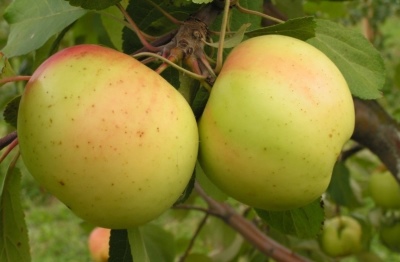
- Taste: sweet and sour
- Scent: with light hints of banana
- Fruit weight, g: 140 — 180
- Yield: (35-40 t / ha) - 25-30 kg / tree
- The beginning of fruiting varieties: on dwarf rootstocks begins in the 3rd year after planting
- Ripening terms: late winter
- Removable maturity: in the second decade of September
- Duration of the consumer period: December - May
- Appointment: universal
- Self-fertility: self-infertile
Both beginners and experienced gardeners strive to find the best varieties of all known fruit trees. This also applies to apple trees, among which the Banana plant is popular.
Breeding history of the variety
The author of this variety was the Belarusian breeders who used the MM106 stock.
Description of the variety
The plant is vigorous, reaching a height of 4 meters. Banana has a rounded crown of medium density with slightly wrinkled and dull leaves.
Features, pros and cons
The advantages of the variety include:
- high productivity;
- large fruits with a tasting score of 4.3 points;
- fruiting for 3 years after planting;
- long-term storage.
One of the disadvantages, according to some gardeners, is the late ripening period.
Ripening and fruiting
As mentioned above, the variety has a late winter ripening period, and removable maturity occurs in the second decade of September. The consumer period lasts from December to May.
Growing regions
The variety is distinguished by high frost resistance, due to which it can be grown even in the northern regions of the country.
Yield
An apple tree of this type has a high yield: 25-30 kg of juicy and large fruits can be harvested from one tree.
Fruits and their taste
Fruits are the main advantage of the Banana variety. They are universal, therefore they are used for fresh consumption, for cooking compotes and jams. Many gardeners say that dried apples retain their delicate and light taste.
Light yellow fruits with a pink blush of spherical shape weigh on average from 140 to 180 grams, and individual apples reach 250 grams. The peel of medium density with pronounced subcutaneous punctures hides a dense yellowish-white flesh underneath. The taste of apples is sweet and sour, thanks to which the fruits are sold well. The aroma with light notes of banana explains the name of the variety - Banana.

Growing features
When planting, you need to take into account the peculiarities of the root system and maintain a distance of 4 meters between rows and from 1.5 to 2.0 meters between plants, depending on the stock.
The trees should be planted in an open and sunny place. The pit is prepared in 2-3 weeks, its depth should be about 70 cm, and its diameter should be at least 1 meter. Banana will dry out if you do not mix humus and compost with the main soil. After planting, the seedling is watered with water in the amount of 4 buckets.
The plant needs:
- weeding;
- loosening the soil around the trunk;
- watering;
- pruning;
- fertilization.



Pollination
The variety is self-fertile, therefore, when growing an apple tree, you need to take care of the presence of pollinating trees nearby.
Top dressing
Mineral and organic fertilizers begin to be applied only 2-3 years after planting. In order for the foliage of the apple tree to develop well, it is necessary to add mixtures that contain nitrogen, potassium and phosphorus. You can also use the following substances:
- urea;
- nitroammophoska;
- ammonium nitrate;
- manure;
- bone flour;
- ash.
At the beginning of spring, nitrogen or complex fertilizer, as well as organic matter with the addition of phosphorus, are introduced into the tree trunk circle. The next top dressing is carried out in the spring: during flowering, urea and humus are introduced. The last fertilization is carried out after harvest: spraying with green fertilizer and applying phosphorus-potassium mixtures.

Frost resistance
The variety is highly frost-resistant, it does not need shelter. Before winter, the trees only need to be whitened.

Diseases and pests
The Banana apple tree has good resistance to scab, other diseases and pests. Without prophylaxis, early detection of the first signs of the disease and treatment with special drugs, the variety can be severely damaged.

The apple tree is a popular fruit crop among gardeners. It can be found in many summer cottages. But at the same time, such trees are often affected by various diseases. It is very important to recognize the disease in time and carry out the necessary procedures for a speedy recovery. Otherwise, the fruits will be spoiled, and the tree itself may die altogether.

Review overview
The opinion of gardeners about the Banana apple variety is mostly positive: they believe that numerous activities for the care and cultivation of the tree fully pay off thanks to the large sweet and sour fruits with a banana aroma, of which there are a lot on the tree.











































































